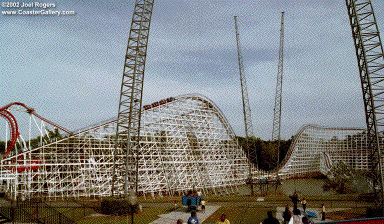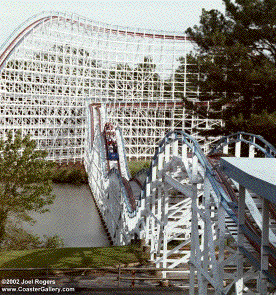

Name of chosen coaster: __________________________
The Great American Scream Machine and the Georgia Cyclone are two examples of old time wooden roller coasters engineered with modern day technology. After riding both coasters, you should have a feel for which coaster goes faster. Each one has differnt speeds at various points, however we can figure out which coaster has the greatest average speed.

Estimate:
Which coaster do you think has the greatest average speed? Make your guess before you calculate numbers!
Hypothesized coaster: ______________________________
The total length of track for the "Screamer" is 3,800 feet. Using a stopwatch, time yourself on the ride from point of departure (as soon as you start moving) until you return to the station (after completely stopping).
Total time of ride _______________ seconds.
Average speed of the Scream Machine ______________ ft/s = _____________ mi/hr
Based on the above calculations, which ride has the greatest average speed? Was your guess correct? What factors influenced you to make the right or wrong decision?

Before you ride:
Stand back and look at the shape of the hills. Sketch the basic shape of one of the curves. This shape is no accident. It was chosen to give you the feeling of falling.
Choose your seat carefully. You will calculate the average speed of the coaster, however, the rider actually feels the instantaneous speed. So the rider in the first seat has a different ride than the one in the last seat. Which rider goes faster, the adventurous front seater or the one seeking the psychological advantage of the back seat? Explain in physics terms. (Try to ride the ride twice-once in the front seat and once in the back seat. Describe the differences in your ride.)

Data:
Height at the highest point of the ride: ________________ meters.
Height at the lowest point of the ride: _________________ meters.
Length of trach (Scream Machine = 3,800 ft and Cyclone = 3,434 ft)
Length of train (length of car x #of cars): _____________ meters.
Radius of the "dip" at the bottom of the first hill: _______________ meters.
Height of the second hill: _____________ meters.
Time for entire ride: __________ seconds
Time for train to pass a point at the top of the first hill: _____________ seconds.
Time for the train to pass a point at the bottom of the first hill: ______________ seconds.
While you ride:
Max acceleration _______________ g's experienced at _______________
Min acceleration _______________ g's experienced at _______________
QUESTIONS AND CALCULATIONS
1. Calculate the average speed of the train for the total ride.
2. Speed at the top of the first hill.
3. Speed at the bottom of the first hill.
4. If all the GPE and KE at the top of the first hill is converted to KE at the bottom of the first hill, how fast is the train going at the bottom of the first hill?
5. How does the calculated speed in #4 compare to that in #3?
6. What is the centripetal acceleration (in g's) in the dip (bottom of the first hill)?
7. What is the total acceleration (in g's) in the dip? How does the total acceleration you calculated compare to your measured value?
8. From your height measurements for the first two hills, estimate the energy lost to friction as a function of track length.
9. Where on the ride did you experience the greate acceleration? In which direction was it? Why there and not another place?
10. Where on this ride did you feel like you were being lifted out of your seat? How did the ride create that feeling?
11. What force causes you to be thrown from side to side in the train car? Describe the shape of the track when you are experiencing this if it helps!
12. Why are the curves banked (sloped toward the inside fo the turn)?
13. What are the elements (in physics terms) that make the roller coaster 'scary'?
OTHER OBSERVATIONS AND QUESTIONS